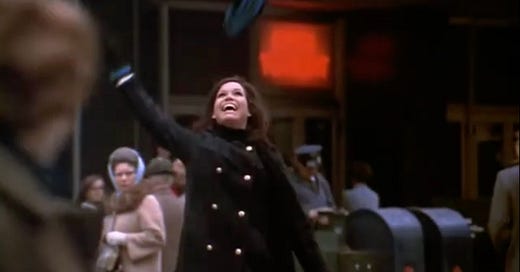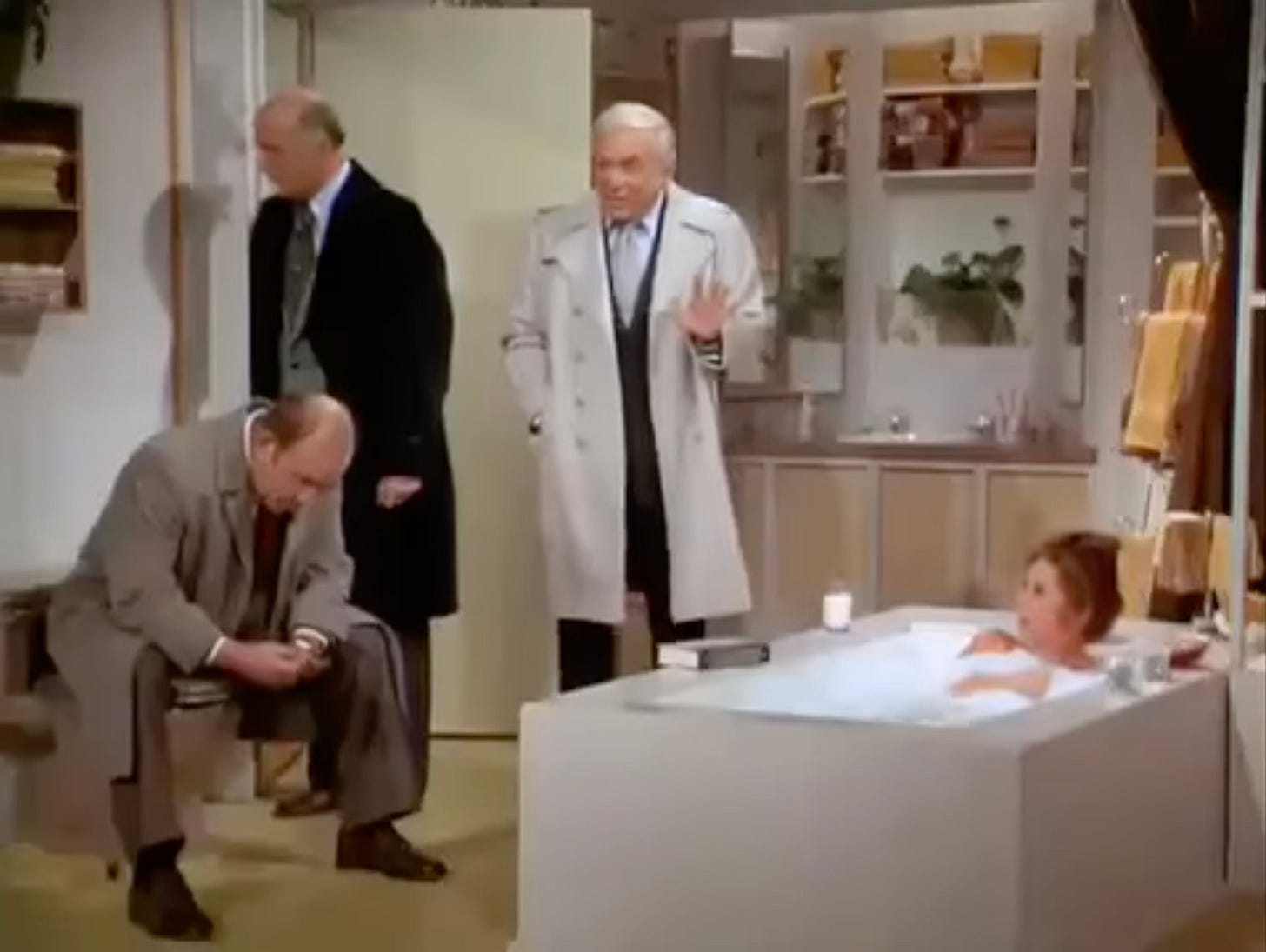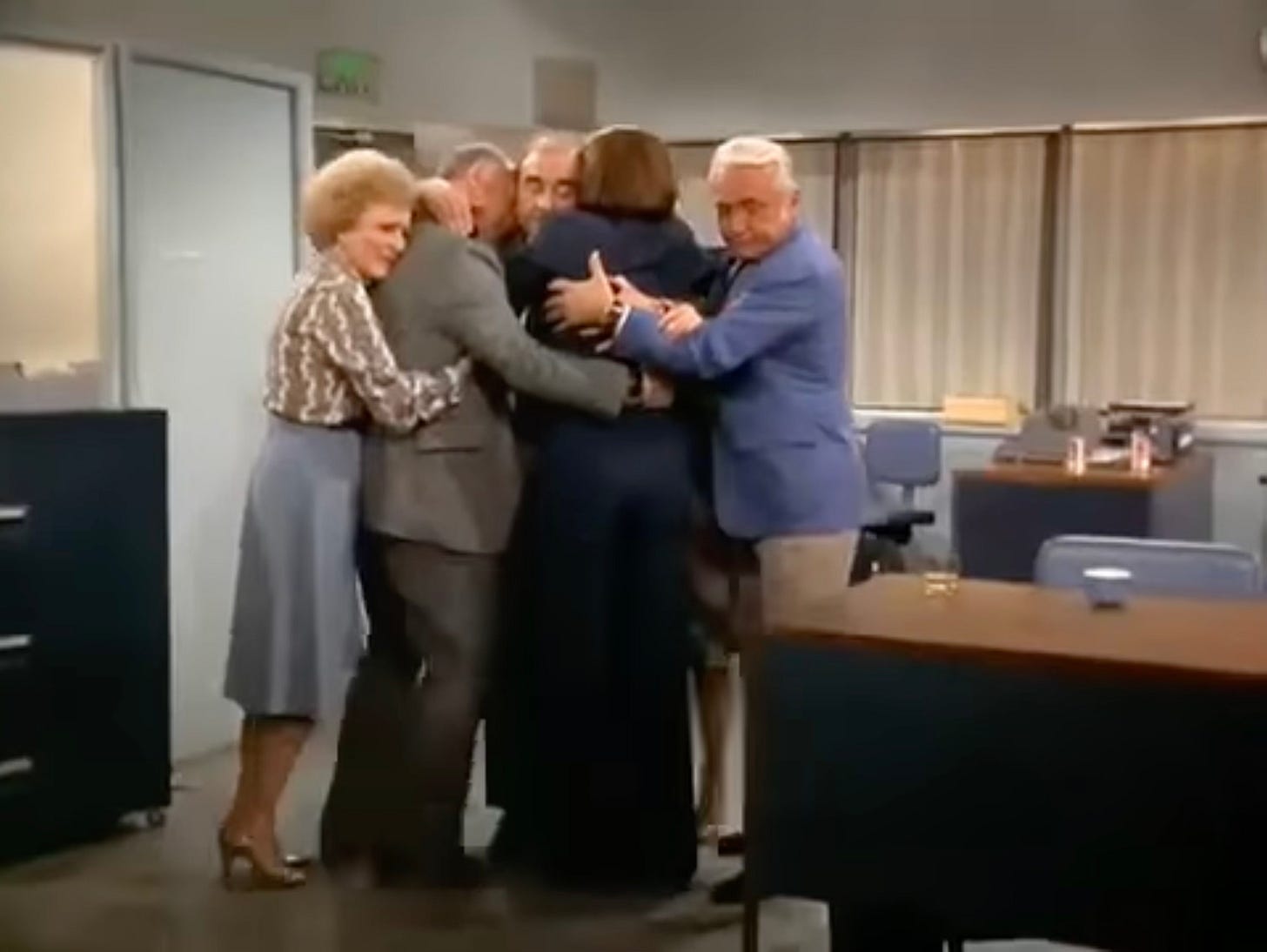Welcome to And the Quest for Pop Culture, where I explore various movies, TV shows, books, and comics. Looking for a different topic or original fiction? Check out the navigation page.
The Mary Tyler Moore Show frequently ranks among the greatest sitcoms of all time. Rolling Stone puts it at number seven. That sounds about right.
There’s plenty to praise about the 1970s series, which set the stage for feminism on television. Modern feminist shows should take some notes from it, namely that women don’t need to be preternaturally gifted and men don’t need to be terrible; people can just be people.
The series, created by James L. Brooks and Allan Burns, ran for seven seasons and 168 episodes. You’d think things would be getting pretty stale by season seven, and for most other series, you’d be correct. But not Mary Tyler Moore. If anything, the show grew more polished and confident with age.
The series had just one glaring age-related drawback in its final two seasons. The earlier seasons struck a nice balance between Mary’s work life and her home life. Representing her home life were her neighbor-turned-best-friend, the down-to-earth Rhoda Morgenstern (Valerie Harper), and her old-friend-turned-landlady, the snobby busybody Phyllis Lindstrom (Cloris Leachman). Phyllis even had a daughter, Bess (Lisa Gerritsen), who was like a niece to Mary.
But both Rhoda and Phyllis spun off into their own separate shows. Rhoda lasted for five seasons, and Phyllis lasted for two. Mary Richards moved into a new apartment in season six, and attempts to introduce new friends and neighbors never clicked.
The workplace cast remained intact, though. We’ve got Ed Asner as Lou Grant, the gruff, hard-drinking boss who can be a bit of a softie on occasion; Gavin MacLeod as Murray Slaughter, the news writer who’s always ready with a quip; and Ted Knight as Ted Baxter, the vain, empty-headed anchorman. (You might also recognize Ted Knight’s voice from the early Superfriends cartoons.)
These three men, along with Mary Tyler Moore herself, form the core cast that persists throughout all seven seasons. WJM, the fictional Minneapolis news station, is the show’s one consistent setting. It seems Mary Tyler Moore just wanted to be a workplace comedy after all.
To fill the void left by Rhoda and Phyllis, two recurring female characters rose to prominence in the final seasons: Betty White as the overly sunny, passive-aggressive Sue Ann Nivens, host of WJM’s Happy Homemaker show; and Georgia Engel as Georgette Franklin, who was introduced as a friend of Rhoda’s but ended up as Ted’s wife. Ted and Georgette complement each other nicely—whereas he’s dumb, self-absorbed, and generally unliked, she’s dumb, sweet, and liked by all. Marriage and fatherhood rescue Ted from becoming nothing more than a buffoonish caricature at the end.
Sue Ann and Georgette have better reasons than Rhoda and Phyllis to pop into the newsroom. However, Lou, Murray, and Ted still pop into Mary’s apartment at a frequency that would alarm any modern HR department—especially that one episode where they pop into her bathroom while Mary is taking a bath and they can’t seem to take the hint that she would prefer to be left alone during this activity.
Mary’s parade of dates continues in the final season, but as before, she’s not on any desperate quest for marriage. If she finds the right guy, great. If not, she’s happy with a career she enjoys and friends she loves. Plenty of episodes have no romantic interest at all, or only a passing reference to one.
The final season maintains many of the familiar beats, such as the frequent “speak of the devil” entrances. Someone says something like “Who would be dumb enough to do that?” And then Ted strolls in, doing precisely that. But the topflight cast and writers have nailed the rhythm to such an extent that even the predictable jokes can be amusing enough.
The season opens with “Mary Midwife,” which features a trope that many sitcoms get to sooner or later: childbirth chaos. While Mary has everyone over for dinner, Georgette goes into labor, and there’s no time to wait for a doctor. It’s up to our main cast to deliver the baby, and in Mary’s bedroom, no less.
The dialogue rolls along, missing no opportunity for a joke:
Mary: Murray, couldn’t you go in there? I mean, after all, you’ve had children.
Murray: No, Marie had the children. Look, I couldn’t even watch when we adopted one. You go in there, Mary.
Mary: No, Murray, a delivery room is no place for a woman!
[Lou enters from the bedroom, carrying a crying Ted.]
And later:
Ted: This is awful. I feel awful. Why didn’t someone warn me childbirth is hell?
Murray: What are we doing out here? A woman is giving birth to a baby in Mary’s bedroom.
Sue Ann: I know, and it’s probably the most exciting thing that’ll ever happen in there.
Classic.
The second and fourth episodes highlight an important element of the show: Mary, though competent at her job, is not a prodigy who immediately excels at everything. She makes mistakes, and there are some things she’s just not that great at.
In “Mary the Writer,” she tries her hand at writing an article to submit to magazines. While ever-supportive Murray loves it, Lou is far more critical. When Mary asks Lou to read the article and tell her what he thinks, he prefers not to, because the old pro knows there’s a strong chance it won’t be any good. And he’s right.
Then, in “What’s Wrong with Swimming?,” Mary thinks it would be a good idea to hire a woman as a sportscaster. And it might have been, had she hired the right woman, but she does not. The woman she hires ends up reporting only on the sports she cares about, like swimming, while ignoring the sports that are far more popular, like, say, football. Mary must not only admit her own error but fix it.
The third episode, “Sue Ann’s Sister,” takes us where no episode had gone before—into Sue Ann’s bedroom. And it is a sight.
Sue Ann, distraught over the prospect of being overshadowed by her sister, succumbs to depression and withdraws into her elaborate bedroom. One by one, Mary and the guys venture in to convince her to return to work. Murray, Ted, and Lou struggle to come up with nice things to say, and they were anything but nice earlier, but they do indeed show her kindness in the end.
It’s one of the good life lessons that classic sitcoms have imparted, one that Cheers later ran with: Annoying people also deserve compassion and dignity (which is good, because there’s a strong chance we’ll all be annoying to someone at some point).
The tenth episode, “Murray Can’t Lose,” is the annual (and final) Teddy Awards episode. Throughout the series, Murray has been depicted as a good news writer whose career never really took off. He’s never won a Teddy Award, but word on the street is that he’s a sure bet this year. Though the rest of the WJM crew sweep the awards, Murray ends the night as the sole loser among them.
Nevertheless, during a post-ceremony gathering at Mary’s apartment, at his wife’s prompting, Murray gives what would have been his acceptance speech. It’s a fitting final-season speech, permitting the show to get sentimental about each main character. Even Ted.
Ted: Come on, Murray, why didn’t you win that award?
Murray: It’s okay, Ted. I don't mind.
Ted: Well I do. If you hadn’t blown it, the whole world would’ve heard how nice I am.
For additional fun, Mary sings “One for My Baby” (badly) and Georgette performs “Steam Heat” (not badly). Plus, Ted demonstrates his ventriloquism skills using Lou as the puppet. It’s the closest the series gets to being a variety show.
Then there’s “Mary’s Insomnia,” which highlights the father/daughter-like dynamic between Lou and Mary. Mary is hooked on sleeping pills, and Lou is determined to help her break the habit, whether she wants his help or not.
Lou is so concerned that he gets the landlord to let him into Mary’s apartment. Terrified that she’s getting high on sleeping pills, he barges into her bathroom to confront her about it. But it turns out that Mary is merely taking a bath. Lou is so relieved that he completely fails to notice how inappropriate his presence is.
It’s the sort of scene that works best late in a show’s long run, and it’s a setup that can only work with innocently dumb sitcom characters.
When Murray shows up, also concerned, Lou thinks nothing of calling him in. So, Murray enters and immediately averts his eyes, and Ted follows a moment later, acting no differently than he would in the office. Lou’s obliviousness, fueled by sincere paternal instincts, sells the whole bit.
Admire the dialogue:
Mary: Mr. Grant, I am taking a bath. Naked!
Lou: Naked?
Mary: Yes. Many people bathe that way. And you are sitting in my bathroom watching me!
Lou: Wait a minute! Wait a minute! I came over here because I was worried about you!
Mary: Yes, I realize that …
Lou: Worried to death! You think I care that you’re in the bathtub?
Mary: Obviously not!
Lou: You think that’s why I came? I was at home with my shoes off, having a beer. Nice and comfortable. You imagine I suddenly said to myself, “Hey. Why don’t I go over and see if I can cop a peek at Mary?”
Mary: Of course not!
Lou: I can’t believe you’d think that of me, Mary. That’s a really rotten thought!
Mary: I’m in no position to argue with you!
Lou: (shaking his head) Aw, you really find out about some people.
Murray: (off camera) Mary, it’s me, Murray!
Mary: Oh, my God!
Murray: (off camera) I was worried about you. I tried to phone, but the phone was busy.
Lou: We’re in here!
Mary: Mr. Grant!
That’s quality sitcom writing there. It’s not just the absurd situation—it’s everything layered into the absurd situation.
The three penultimate episodes are a bit off, but that’s only because the cast and crew seized the opportunity for last-minute experimentation. “Mary’s Three Husbands” has Lou, Murray, and Ted each wondering what it would be like to be married to Mary, thereby allowing this longtime ensemble to perform in entirely new scenarios. Next, “Mary’s Big Party” serves as a clip show to highlight some of Mary’s previous disastrous parties. The episode isn’t entirely recycled material, though, and Johnny Carson guest-stars during a blackout—heard, but not seen.
And then there’s “Lou Dates Mary.” Mary is fed up with a string of terrible dates, and Georgette convinces her that maybe Lou is the man she’s been looking for all along. It’s a terrible idea, of course, and the writers had enough sense to realize that early on. Watching Lou and Mary attempt a date is painfully uncomfortable, and they realize they’re much better off as friends and colleagues. We didn’t need an episode to arrive at an answer everyone had known all along.
But the final episode hits the right note to end on—in a literal sense, too, with the cast singing “It’s a Long Way to Tipperary” on their way out. Everyone gets fired (except Ted, the least competent of the bunch, naturally), leading to one of the funnier group hugs committed to film.
Before that, though, Rhoda and Phyllis return for one last scene with Mary. As they cheer her up, showing her genuine friendship outside of the newsroom, we see the void their departures created.
Mary sums up the series nicely in its final scene: “Last night, I thought, ‘What is a family, anyway?’ They’re just people who make you feel less alone, and really loved. And that’s what you've done for me. Thank you for being my family.”
Countless sitcoms would follow The Mary Tyler Moore Show, but so few would be so successful in gathering exactly the right group of actors and writers at exactly the right time. Maybe six or so.
The series generated one more spin-off—an Emmy-winning drama, surprisingly enough. Ed Asner starred in Lou Grant for five seasons.
That’s a whole different tone there. I’ve never watched Lou Grant. I’m curious how a sitcom character becomes a dramatic character, but I don’t doubt that Asner could pull it off. If you’ve seen it, let me know what you think.









Fittingly, the final season scored well at the Emmys, with the final episode in particular earning a prize for its script.